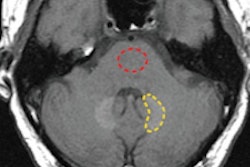Korean researchers have found that patients who previously experienced immediate adverse reactions to gadolinium-based MRI contrast agents have a 30% recurrence rate when given the media a second time, according to a study in the August issue of Radiology.
The research from Seoul National University determined an overall incidence rate of 0.121% for the frequency of adverse reactions among more than 84,000 patients given different types of gadolinium-based MRI contrast media.
The study group, led by Dr. Jae-Woo Jung, PhD, from the department of internal medicine, also tallied a total of 112 immediate hypersensitivity reactions (0.079%) among 141,623 contrast media doses given at Seoul National University Hospital (Radiology, August 2012, Vol. 264:2, pp. 414-422).
Risk of NSF
The greatest danger in administering gadolinium-based MRI contrast agents is the risk of nephrogenic systemic fibrosis (NSF). The debilitating affliction is characterized by widespread tissue fibrosis and has been reported in dialysis patients and those with insufficient renal function. The rate of NSF has decreased dramatically in recent years, as healthcare providers have taken precautions to avoid giving the contrast agents to potentially at-risk patients.
The retrospective study included patients who were given gadolinium-based MRI contrast media at the facility between August 2004 and July 2010. The researchers collected data on immediate hypersensitivity reactions, the kind of MRI contrast media used, and the patients' demographic information, including age, sex, and comorbidity factors.
Gadolinium-based contrast media given to patients included Dotarem from Guerbet; Bayer HealthCare Pharmaceuticals' Gadovist, Magnevist, and Primovist; Omniscan from GE Healthcare; and Bracco Diagnostics' MultiHance.
Mild reactions included rashes, hives, coughing, and swelling of the eyes and face. Moderate reactions included bronchospasm, laryngeal edema, and generalized erythema. More severe reactions were considered life-threatening and included severe laryngeal edema, convulsions, hypotension, unresponsiveness, arrhythmia, and cardiopulmonary arrest.
Adverse reactions
The database revealed 141,623 MRI scans with contrast media in 84,367 patients during the six-year period. The number of patient exposures to MRI contrast media varied from one to 54 per patient, with a mean of 1.7. A total of 60,925 individuals (72%) were given gadolinium-based contrast media only once.
The researchers discovered 112 immediate adverse reactions (0.079%), which occurred in 102 (0.121%) patients.
Gadobenate dimeglumine (MultiHance) had the highest rate of immediate hypersensitivity reactions, with 14 incidents (0.22%) among 6,361 administrations. Additional rates were as follows:
- Gadoxetic acid (Primovist) with six reactions (0.116%) among 5,152 administrations
- Gadobutrol (Gadovist) with 33 reactions (0.099%) among 33,242 administrations
- Gadoteric acid (Dotarem) with 31 reactions (0.080%) among 38,580 administrations
- Gadopentetate (Magnevist) with 26 reactions (0.061%) among 42,323 administrations
- Gadodiamide (Omniscan) with two reactions (0.013%) among 15,959 administrations
The incidence of immediate hypersensitivity reactions among women was double the rate among men, Jung and colleagues also noted. A total of 73 women (0.098%) experienced reactions among the 74,066 women in the study, compared with 39 men (0.058%) among the 67,557 men in the study.
Resulting symptoms
Among the 112 immediate hypersensitivity reactions, hives was the most common symptom, seen in 102 cases (91%), while respiratory issues occurred in 17 cases (15%) and hypotension afflicted 11 patients (10%). Other adverse reactions included six cases (5%) of swelling. There were 19 patients (70%) with multiple symptoms.
Severe adverse reactions occurred in 10 patients, all of which were diagnosed as anaphylaxis.
The one fatality in the study was a 76-year-old woman who developed hypotension, nausea, and decreased consciousness after gadobutrol injection. Thus, the mortality rate was 0.0007%.
Of the 102 patients who had immediate hypersensitivity reactions for the first time, 60 (59%) had hypersensitivity symptoms at their first exposure to the MRI contrast media.
"However, 42 patients (41%) had already been exposed to MR contrast media before the development of immediate hypersensitivity reactions, including 28 patients (27%) who had been exposed to exactly the same MR contrast agent," the authors noted.
Incidence of immediate adverse reactions from contrast exposure
|
||||||||||||||||||||
| Source: Radiology. |
The study also revealed that the incidence of immediate adverse reactions was 0.105% (61 of 57,966 patients) for one exposure to the contrast media, 0.137% (17 of 12,381 patients) for two exposures, and 0.171% (24 of 14,020 patients) for at least three exposures to the contrast media.
"This trend was maintained in patients with a mild reaction, but not in patients with moderate or severe reactions," Jung and colleagues wrote.
Based on the recurrence of immediate adverse reactions, physicians should consider "appropriate premedication with antihistamine or systemic corticosteroid ... according to the severity of the previous hypersensitivity reactions," the group concluded.



.fFmgij6Hin.png?auto=compress%2Cformat&fit=crop&h=100&q=70&w=100)




.fFmgij6Hin.png?auto=compress%2Cformat&fit=crop&h=167&q=70&w=250)











